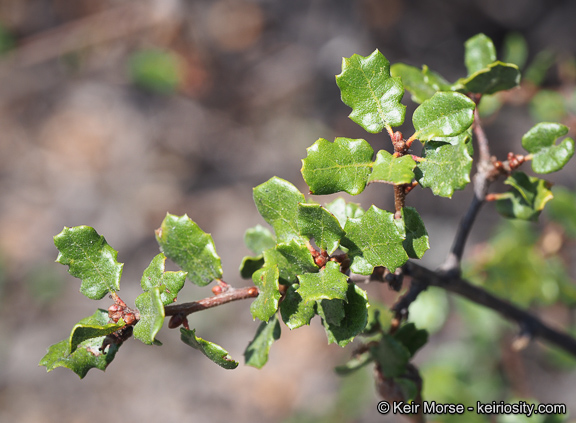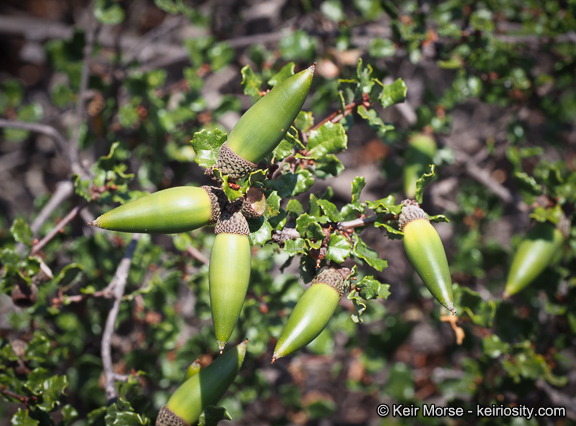
Nuttall's Scrub Oak
Quercus dumosa
Quercus dumosa

Nuttall's Scrub Oak
Quercus dumosa
Quercus dumosa
| File name | Lead Author | Year | Type |
|---|---|---|---|
| 2010-11 Baseline Survey Report for the Jamul Mountains Parcels of the the Otay Ranch Preserve | O'Meara, Cailin; Sundberg, J.R.; Dodero, Mark | 2011 | report |
| FINAL HABITAT MANAGEMENT PLAN for Starwood - Santa Fe Valley SECOND AMENDMENT | 2000 | report | |
| Habitat Management Plan for the Kelly Ranch Habitat Conservation Area | 2002 | report | |
| Habitat Management Plan for the Kelly Ranch Habitat Conservation Area (2008 -2013) | McConnell, Patrick; Vinje, Jessie; Spiegelberg, Markus | 2008 | report |
| La Costa Collection Townhomes Preserve Preserve Management Plan | 2012 | report | |
| Poinsettia Place Preserve Management Plan | 2011 | report | |
| Preserve Management Plan for the Cantarini Ranch Preserve, Carlsbad, California | Loeffler, Wendy | 2011 | report |
| PRESERVE MANAGEMENT PLAN for the MUROYA PROPERTY CITY OF CARLSBAD, CALIFORNIA | Hayworth PhD, Anita M. | 2011 | report |
South coast and Peninsular Ranges of Santa Barbara, Ventura, Los Angeles, Orange, and San Diego County, as well as Baja California, Mexico [1, 2].
Thirty occurrences on Conserved Lands in Mus 1 (Cabrillo National Monument), 2 (Florida Canyon, Rose Canyon Open Space, Soledad Natural Park, Switzer Canyon, Tecolote Canyon Natural Park, Tierra Santa Open Space), 3 (Otay Ranch Preserve, San Diego National Wildlife Refuge), 4 (Elliot Reserve, International University Open Space, Mission Trails Regional Park, Sycamore Canyon), 6 (Black Mountain Open Space Park, Carmel Valley Restoration and Enhancement Project, Del Mar Heights, Del Mar Mesa Open Space, Faraday Open Space, Los Penasquitos Canyon Preserve, Lusardi Creek Preserve, Manchester Mitigation Bank, Overlook Park, Rancho La Costa Habitat Conservation Area, San Elijo Reserve Ecological Reserve, the Crosby at Rancho Sante Fe, Torrey Pines State Natural Reserve ), 7 (Torrey Pines State Natural Reserve), and 10 (Santa Ysabel West Open Space Preserve).
None [2].
Sandy, clay loam of closed-cone coniferous forest, chaparral, and coastal scrub [2]. Elevation range is 15-400 meters [1].
Fagaceae family [2].
Perennial evergreen shrub to tree [2]. Lifespan up to 100 years old [3, 4]. Good recruitment requires a year of abundant rain on chaparral that has not burned for 50 years or more [7, 9]. Slow growing [3].
Bloom period is February-August [2].
Acorns mature in 1 year [5, 6] and rain stimulates germination [7]. Acorns dispersed by granivorous animals or fall near the tree [7, 9, 10]. Monoecious plant [8].
Development, fire suppression, and vegetation/fuels management [2]. Possibly threatened by hybridization with Q. berberidifolia.
Hybridizes with Q. berberidifolia, Q. lobata, and Q. dumosa ssp. kinseliae [1]. Stump sprouts after fire and cutting [8]. Viable acorns can be picked 1.5-2 months before maturity, and after proper drying, can be stored for 1 year at 3-4 degree Celsius [4].
[1] Rosatti, T.J., and J. M. Tucker 2016. Quercus dumosa, Revision 2, in Jepson Flora Project (eds.) Jepson eFlora, http://ucjeps.berkeley.edu/cgi-bin/get_IJM.pl?tid=40582, accessed on September 08, 2016.
[2] CNPS, Rare Plant Program. 2016. Inventory of Rare and Endangered Plants (online edition, v8-02). California Native Plant Society, Sacramento, CA. http://www.rareplants.cnps.org, accessed 08 September 2016.
[3] Horton, J. S., and C. J. Kraebel. 1955. “Development of Vegetation after Fire in the Chamise Chaparral of Southern California.†Ecology 36 (2): 244–62.
[4] Plumb, T. R., and A. P. Gomez. 1983. “Five Southern California Oaks: Identification and Postfire Management.†Berkeley, CA.
[5] Hickman, J. C. 1993. The Jepson Manual: Higher Plants of California. Berkeley, CA: University of California Press.
[6] Adams, L. 1904. “Quercus Wislizeni in Southern California.†Bulletin of the Southern California Academy of Sciences 3 (1): 1–2.
[7] Keeley, J E. 1991. “Seed Germination and Life History Syndromes in the Californian Chaparral.†The Botanical Review. Los Angeles, CA: New York Botanical Garden.
[8] Eugene, C.C. 1987. “Common Shrubs of Chaparral and Associated Ecosystems of Southern California.†Pacific Southwest Forest and Range Experiment Station.
[9] Keeley, J. E. 1997. “Seed Longevity of Non-Fire-Recruiting Chaparral Shrubs.†Four Seasons 10 (3): 36–42.
[10] Plumb, T.R., and P. M. McDonald. 1981. “Oak Management in California.†General Technical Report PSW-54, 1–18.